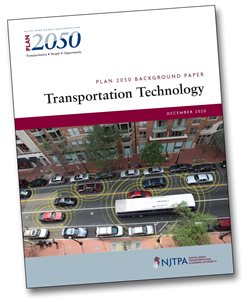 Within the next decade, connected and automated vehicles could make the transportation system much safer and dramatically more efficient. But the NJTPA and other agencies must guide how such new technologies are integrated into the transportation network, according to Transportation Technology, a background paper issued to inform the update of NJTPA’s long range transportation plan, Plan 2050: Transportation, People, Opportunity.
Within the next decade, connected and automated vehicles could make the transportation system much safer and dramatically more efficient. But the NJTPA and other agencies must guide how such new technologies are integrated into the transportation network, according to Transportation Technology, a background paper issued to inform the update of NJTPA’s long range transportation plan, Plan 2050: Transportation, People, Opportunity.
The NJTPA currently coordinates with its partner agencies in funding and implementing a variety of beneficial transportation technologies—collectively referred to as Intelligent Transportation Systems or ITS. They include adaptive traffic signal systems, sensors that gather real time data from roads and rails, and traffic operations centers. All make use of a statewide ITS “architecture,” an information resource of agreed-upon technical standards and strategies.
The paper foresees that within the next decade there will be progress in implementing connected vehicle technology, which will allow the coordination of vehicles as they travel, including the platooning of cars and trucks on highways and allowing vehicles to avoid hazards. The technology uses short to medium range communications between vehicles, and between vehicles and infrastructure.
Automated vehicles are also coming. Automation ranges from driver assistance such as adaptive cruise control and lane assist (now on many vehicles), to self-parking and fully autonomous vehicles. Best estimates are that fully driverless vehicles will emerge in limited forms in the next decade, likely operating in constrained areas at low speeds.
Widespread use of connected and automated vehicles, the paper says, could reduce crashes by 80 percent or more and transform regional land use. Many downtowns now devote 50 to 60 percent of their scarce real estate to vehicles, including parking and roads. This will decline as residents rely less on personal autos.
As North Jersey’s Metropolitan Planning Organization (MPO), the NJTPA will have to assist in planning how connected and automated vehicles are integrated into local and regional networks, including prioritizing investments and ensuring all residents share in the benefits.
According to the Association of Metropolitan Planning Organizations, MPOs like the NJTPA “have the opportunity to help weave vehicle connectivity and automation into the transportation system in a way that is context sensitive to the existing urban fabric and community vision and helps meet regional goals and needs.”
The paper summarizes many of the current technologies supported by the NJTPA. This includes technologies used in planning, such as sophisticated traffic counting, Geographic Information Systems (GIS), use of archived real-time data in modeling, 3D visualization and more.
The paper offers a host of recommendations. Among the topics are:
-
Continue and Expand ITS Investments and Invest in Hardware, Software and Infrastructure
-
Encourage Shared Rides and Support Transit
-
Prioritize Safety and Privacy
-
Ensure Equitable Access, Address Mobility Gaps and Promote Social Benefits
-
Promote High Speed Internet Access for all
-
Use technology to address climate change and support sustainability
-
Ensure public input and education about technology
-
Expand Transportation Information and make data accessible
To read this paper and other documents that are informing development of Plan 2050, visit njtpa.org/Plan2050.